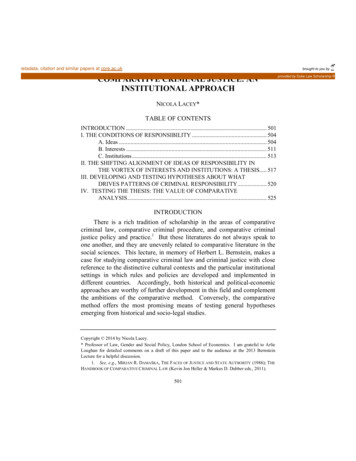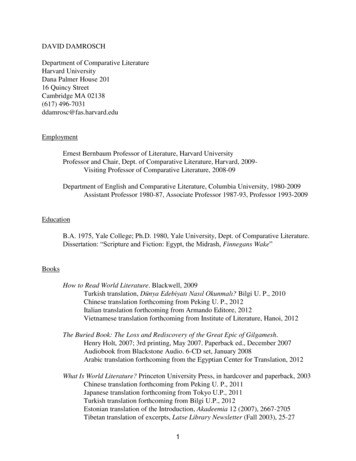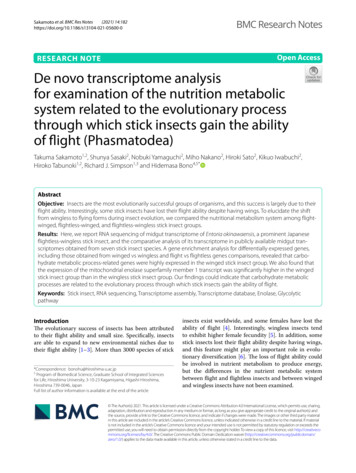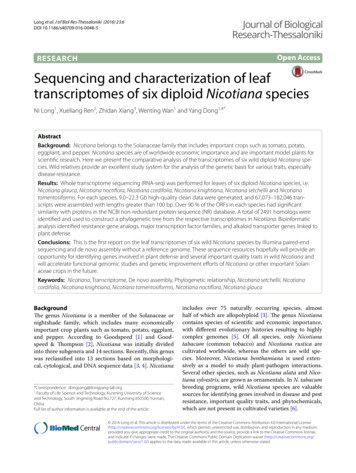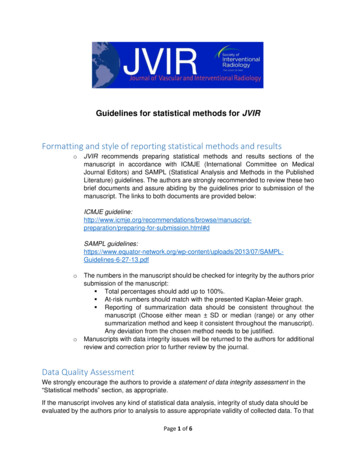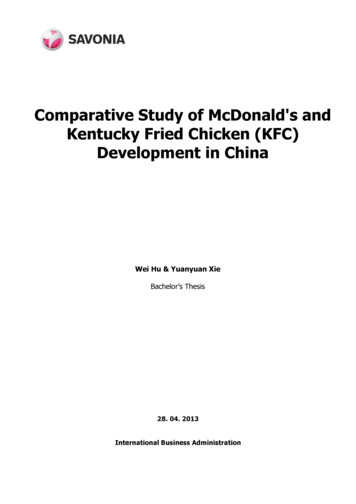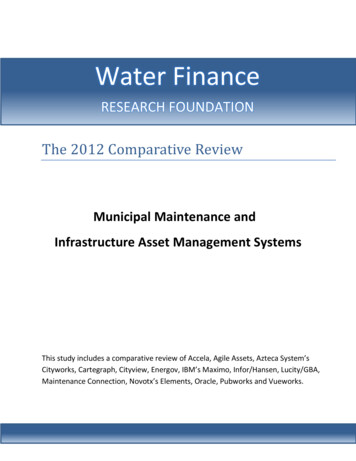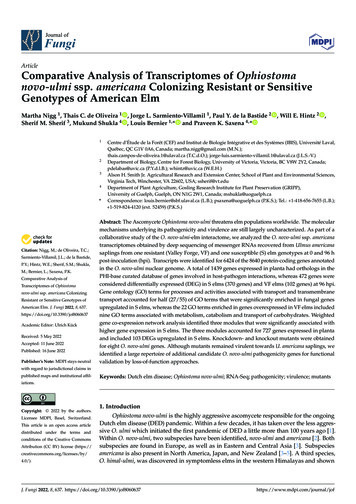
Transcription
Journal ofFungiArticleComparative Analysis of Transcriptomes of Ophiostomanovo-ulmi ssp. americana Colonizing Resistant or SensitiveGenotypes of American ElmMartha Nigg 1 , Thais C. de Oliveira 1 , Jorge L. Sarmiento-Villamil 1 , Paul Y. de la Bastide 2 , Will E. Hintz 2 ,Sherif M. Sherif 3 , Mukund Shukla 4 , Louis Bernier 1, * and Praveen K. Saxena 4, *1234*Citation: Nigg, M.; de Oliveira, T.C.;Sarmiento-Villamil, J.L.; de la Bastide,P.Y.; Hintz, W.E.; Sherif, S.M.; Shukla,M.; Bernier, L.; Saxena, P.K.Comparative Analysis ofTranscriptomes of Ophiostomanovo-ulmi ssp. americana ColonizingResistant or Sensitive Genotypes ofAmerican Elm. J. Fungi 2022, 8, 637.https://doi.org/10.3390/jof8060637Academic Editor: Ulrich KückReceived: 5 May 2022Accepted: 11 June 2022Published: 16 June 2022Publisher’s Note: MDPI stays neutralCentre d’Étude de la Forêt (CEF) and Institut de Biologie Intégrative et des Systèmes (IBIS), Université Laval,Québec, QC G1V 0A6, Canada; martha.nigg@gmail.com (M.N.);thais.campos-de-oliveira.1@ulaval.ca (T.C.d.O.); jorge-luis.sarmiento-villamil.1@ulaval.ca (J.L.S.-V.)Department of Biology, Centre for Forest Biology, University of Victoria, Victoria, BC V8W 2Y2, Canada;pdelabas@uvic.ca (P.Y.d.l.B.); whintz@uvic.ca (W.E.H.)Alson H. Smith Jr. Agricultural Research and Extension Center, School of Plant and Environmental Sciences,Virginia Tech, Winchester, VA 22602, USA; ssherif@vt.eduDepartment of Plant Agriculture, Gosling Research Institute for Plant Preservation (GRIPP),University of Guelph, Guelph, ON N1G 2W1, Canada; mshukla@uoguelph.caCorrespondence: louis.bernier@sbf.ulaval.ca (L.B.); psaxena@uoguelph.ca (P.K.S.); Tel.: 1-418-656-7655 (L.B.); 1-519-824-4120 (ext. 52459) (P.K.S.)Abstract: The Ascomycete Ophiostoma novo-ulmi threatens elm populations worldwide. The molecularmechanisms underlying its pathogenicity and virulence are still largely uncharacterized. As part of acollaborative study of the O. novo-ulmi-elm interactome, we analyzed the O. novo-ulmi ssp. americanatranscriptomes obtained by deep sequencing of messenger RNAs recovered from Ulmus americanasaplings from one resistant (Valley Forge, VF) and one susceptible (S) elm genotypes at 0 and 96 hpost-inoculation (hpi). Transcripts were identified for 6424 of the 8640 protein-coding genes annotatedin the O. novo-ulmi nuclear genome. A total of 1439 genes expressed in planta had orthologs in thePHI-base curated database of genes involved in host-pathogen interactions, whereas 472 genes wereconsidered differentially expressed (DEG) in S elms (370 genes) and VF elms (102 genes) at 96 hpi.Gene ontology (GO) terms for processes and activities associated with transport and transmembranetransport accounted for half (27/55) of GO terms that were significantly enriched in fungal genesupregulated in S elms, whereas the 22 GO terms enriched in genes overexpressed in VF elms includednine GO terms associated with metabolism, catabolism and transport of carbohydrates. Weightedgene co-expression network analysis identified three modules that were significantly associated withhigher gene expression in S elms. The three modules accounted for 727 genes expressed in plantaand included 103 DEGs upregulated in S elms. Knockdown- and knockout mutants were obtainedfor eight O. novo-ulmi genes. Although mutants remained virulent towards U. americana saplings, weidentified a large repertoire of additional candidate O. novo-ulmi pathogenicity genes for functionalvalidation by loss-of-function approaches.with regard to jurisdictional claims inpublished maps and institutional affil-Keywords: Dutch elm disease; Ophiostoma novo-ulmi; RNA-Seq; pathogenicity; virulence; mutantsiations.Copyright: 2022 by the authors.Licensee MDPI, Basel, Switzerland.This article is an open access articledistributed under the terms andconditions of the Creative CommonsAttribution (CC BY) license (https://creativecommons.org/licenses/by/4.0/).1. IntroductionOphiostoma novo-ulmi is the highly aggressive ascomycete responsible for the ongoingDutch elm disease (DED) pandemic. Within a few decades, it has taken over the less aggressive O. ulmi which initiated the first pandemic of DED a little more than 100 years ago [1].Within O. novo-ulmi, two subspecies have been identified, novo-ulmi and americana [2]. Bothsubspecies are found in Europe, as well as in Eastern and Central Asia [3]. Subspeciesamericana is also present in North America, Japan, and New Zealand [3–5]. A third species,O. himal-ulmi, was discovered in symptomless elms in the western Himalayas and shownJ. Fungi 2022, 8, 637. .com/journal/jof
J. Fungi 2022, 8, 6372 of 23to be pathogenic to European elms by controlled inoculations [6]. The first full genomesequences of DED fungi were released in 2013. They were obtained for O. ulmi strain W9 [7]and O. novo-ulmi ssp. novo-ulmi strain H327 [8]. The latter is a model for investigationsof DED pathogens [9,10] and its genome has been fully assembled and annotated [8,11].This, in turn, has facilitated assemblies of additional genomes used in population studiesof O. ulmi and O. novo-ulmi [12].In nature, DED fungi are vectored by elm bark beetles belonging to the genera Scolytusand Hylurgopinus [13]. Young adult bark beetles feed in the crown of adult, healthy elms inearly summer. Beetles carrying conidia of DED fungi on their exoskeleton inoculate thepathogen when they bore though the bark of twig crotches. Once inoculated, the fungusgrows into the water conducting system and induces tree defense responses. The DEDfungi are dimorphic (i.e., capable of switching growth phases from yeast to mycelium in areversible manner, depending on environmental conditions) [14]. Expressed sequence tag(EST) analyses of O. novo-ulmi strain H327 during yeast growth allowed the identification ofclose to 2100 genes expressed under this growth form [15]. Subsequently, RNA-Seq-basedtranscriptomic studies of strain H327 grown in vitro showed that 12% of the gene contentwas differentially expressed between the two growth phases [16] and that the transcriptomechanged significantly within two hours of the transition from yeast growth to mycelialgrowth [17]. Although yeast-mycelium transition is thought to contribute to parasiticfitness of the DED fungi [10], no in planta expression data are available for this trait.The genes and molecular pathways that allow DED fungi to invade host tissues following inoculation are largely unknown. Analysis of F1 progeny from controlled crossesbetween O. ulmi and O. novo-ulmi (originally thought to be a more aggressive form ofO. ulmi) indicated that pathogenicity was under polygenic control [18]. Annotation of theO. novo-ulmi H327 genome revealed that 1731 genes (20% of gene content) had orthologsin the PHI-base curated database of genes involved in host-pathogen interactions [11].Yet, very little experimental evidence is available for candidate pathogenicity genes ofDED fungi. For instance, the cu gene (OnuG4296) encoding a hydrophobin known ascerato-ulmin [19] was shown to be important for spore attachment to bark beetles [20] butnot for pathogenicity towards American elm saplings [21]. Likewise, gene epg1 (OnuG1567)encoding an endopolygalacturonase is likely not a major contributor to pathogenicity sincea null mutant was only slightly less virulent than its wild-type progenitor [22]. The pat1locus, identified by genetic analysis of crosses between O. novo-ulmi H327 and a less virulent introgressant [23], was mapped to a 40 Kb long portion of the largest chromosome ofstrain H327 genome [24] but it is not known whether it is directly controlling pathogenicityor tightly linked to a bona fide pathogenicity gene. Mapping data and functional characterization are also required for a yet uncharacterized gene involved in the production ofyeast-like spores and synnematal spores, and possibly pathogenicity [25,26].Functional validation of candidate pathogenicity genes in O. novo-ulmi has long beenimpeded by the low recovery frequency of targeted mutants, which makes the screeningof potential mutants a tedious procedure [22]. The impact of this obstacle was lowered byusing RNA interference [27] to produce knockdown mutants containing a carbon sourceregulated promoter to drive cassette expression and downregulate specific genes or genefamilies identified through sequence analysis [28,29]. More recently, targeted knockoutmutants were recovered at high frequency after subjecting a mus52 derivative of strainH327 defective for non-homologous end-joining of DNA (NHEJ) to a dual selection systemin OSCAR plasmids [30]. The next development in this area will likely be the developmentof protocols based on CRISPR/Cas (Clustered regularly interspersed short palindromicrepeats/CRISPR associated; [31]) for precise genome editing in O. novo-ulmi [32]. Functional validation of candidate pathogenicity genes would also be facilitated by data fromcomprehensive transcriptomic analyses of elm-O. novo-ulmi interactions. Previous research,however, has focused on transcripts from the host [33,34] rather than from the pathogen.One technical reason for this situation has been the difficulty in recovering sufficientamounts of fungal transcripts since the latter represent a small proportion of the total
J. Fungi 2022, 8, 6373 of 23population of messenger RNAs in inoculated elm tissue. This is no longer a problem thanksto continuing improvements in high throughput sequencing. Here we present the transcriptomes of O. novo-ulmi ssp. americana strain MH75-4O recovered from susceptible as wellas resistant American elms and subjected to deep RNA sequencing. Elm transcriptomesobtained from the same experiment were recently presented in a distinct publication [35].We conducted in silico analyses of the fungal transcriptomes and assessed the contributionof selected genes to pathogenicity by inoculating knockdown- and knockout mutants ofO. novo-ulmi ssp. novo-ulmi.2. Materials and Methods2.1. Fungal IsolatesDue to quarantine issues, elm saplings used for the transcriptome analysis conductedat the University of Guelph campus (Guelph, ON, Canada) could not be inoculated withreference strain O. novo-ulmi ssp novo-ulmi H327. Instead, elms were inoculated withO. novo-ulmi ssp. americana strain MH75-4O which had been used in previous molecularinvestigations of American elm response to infection [36]. Strain MH75-4O originates fromstrain MH75 collected in Toronto (ON, Canada) by Martin Hubbes and has since beensequentially inoculated and recovered four times. Mutant strains for functional validationof candidate genes were derived from strain O. novo-ulmi H327. Controlled inoculationsof mutants were carried out in facilities on the Laval U. campus (Quebec, QC, Canada)that were certified PPC-1 by the Canadian Food Inspection Agency. All strains are kept at 80 C in the Centre for Forest Research (Quebec, QC, Canada) culture collection.2.2. Inoculations and Recovery of Transcripts from Elm-Ophiostoma novo-ulmi InteractionFour-year-old saplings of two types of American elm (Ulmus americana) were usedfor transcriptomic analysis of the elm-O. novo-ulmi interaction: DED resistant ‘ValleyForge’ (VF) purchased from Connon Nurseries (West Flamborough, ON, Canada) andsusceptible (S) elm plant material selected from clones of a susceptible elm tree in thein vitro germplasm bank at the Gosling Research Institute for Plant Preservation (GRIPP),University of Guelph. Saplings were inoculated with strain MH75-4O. Inoculations werecarried out in triplicate. Total RNA was extracted from inoculated elms at 0 and 96 h postinoculation (hpi), respectively, as described previously [35,36]. Twelve complementaryDNA (cDNA) libraries were subjected to RNA-Seq. Detailed procedures for inoculation,RNA extraction, RNA sequencing and filtering of raw RNA-Seq data are provided inIslam et al. [35].2.3. Ophiostoma novo-ulmi ssp. americana Transcriptome Mapping and AnalysisFiltered reads were mapped onto the O. novo-ulmi ssp. novo-ulmi H327 exonic sequences [8] with TopHat2 (v.2.0.10) using default parameters for paired-end RNA-Seqsequencing products [37]. All further analyses were performed using R (v3.0.1; [38]). Readcounts for each of the twelve samples were extracted and used for differential expressionanalyses using the EdgeR package in Bioconductor 3.0 [39]. Genes that were representedby a total of at least three reads (cpm 3) among the three replicates of a condition werekept for downstream analyses. Library sizes (i.e., number of mapped reads) were correctedusing a method based on Trimmed Mean of M-values (TMM) [40,41].A gene was considered upregulated when it was over-expressed at least with a log2Fold Change (log2 FC) 1 (thus expressed at least two times more in one of the twoconditions). Gene Ontology (GO) term enrichment analyses were performed on sets ofoverexpressed fungal genes at 96h in S and VF varieties as described previously [16,17].Ophiostoma novo-ulmi gene transcription patterns during infection of S and VF U. americanasaplings were investigated by Weighted Gene Co-expression Network Analysis (WGCNA)using the WGCNA package in R [42]. The gene matrix was constructed with a thresholdof 20 for n 6. All modules were hierarchically clustered based on topological overlapmatrix (TOM) similarity. Modules containing 100 genes or less were merged with their
J. Fungi 2022, 8, 6374 of 23closest larger neighbor module. Representative Kyoto Encyclopedia of Genes and Genomes(KEGG; [43]) pathways were identified within modules that were significantly associatedwith different levels of fungal expression in S and VF elms. Interaction networks of genesof interest within modules were visualized using Cytoscape 3.9.0 [44].2.4. Functional Analysis of Candidate Pathogenicity GenesNine candidate O. novo-ulmi genes were selected for functional analysis based on theirexpression in planta or in vitro (see 3.4 for details). We first produced knockdown mutantsby RNA interference of the following genes: amtA (OnuG0282), mad1 (OnuG3773), hex1(OnuG6790.1), cyp570 (OnuG7411), cyp52P6 (OnuG7466) and cox2 (OnuG5504.1). RNAicassettes were built to down-regulate the expression of candidate genes using O. novo-ulmiH327 nucleotide sequence data [11]. A DNA cassette was constructed to drive the expression of a gene-specific double-stranded RNA (dsRNA) based upon a functional codingregion of each target gene. The basic design of the RNAi cassette was synthesized byGeneArt Gene Synthesis (Invitrogen, ThermoFisher Scientific, Mississauga, ON Canada),inserted into the holding vector pMK-RQ (kanR) at cloning sites of SfiI/SfiI and purified after growth in the transformed bacterial host Escherichia coli K12 DH10B T1R. EachRNAi construct included a initial SpeI restriction enzyme site, an approximately 600 bpantisense sequence followed by an approximately 400 bp sense sequence and a terminalKpnI restriction enzyme site to facilitate insertion into the transformation vector pAN7-1(Table S1).A universal expression cassette was designed to evaluate candidate genes using thepAN7-1 fungal transformation vector and was synthesized by GeneArt Gene Synthesis.The TrpC transcription terminator of the pAN7 vector [45] was excised by a BamHI/HindIIIrestriction digest and replaced by the O. novo-ulmi alcohol dehydrogenase (alcA) promoterthat was used to regulate RNAi cassette expression, as it is differentially regulated by carbonsource [29]. A version of the alcA promoter lacking two HindIII restriction sites was synthesized to facilitate fungal transformations using an existing HindIII site in the pAN7-1 vector.The transcription of RNAi cassettes inserted at the multiple cloning site (MCS) was terminated by the TrpC terminator from Aspergillus nidulans [45]. The screening of holding vectorsand candidate gene sequences identified six restriction enzymes suitable for the MCS (SpeI,BspDI, AscI, 8 nucleotide spacer (ATGCGAAG), XmaI, NotI and KpnI) that was placedbetween the alcA promoter and TrpC terminator to facilitate the insertion of each RNAicassette tailed with unique restriction sites (TrpC-alcA-(SpeI)-RNAi cassette-(KpnI)-TrpC).The pAN7 vector includes a constitutive glyceraldehyde-3-phosphate dehydrogenase(gpd) promoter sequence of A. nidulans [45] that drives expression of the hygromycin resistance gene (hph) and is tailed by endogenous BamHI and HindIII restriction sites. Expressionof hph confers hygromycin resistance and confirms successful integration of transformingDNA. Insertion of each RNAi cassette was facilitated by a SpeI/KpnI restriction enzymedouble digest in which the pAN7 vector loses 46 bp within the MCS and the pMK vectorreleases an approximately 1000 bp fragment containing the RNAi cassette. All constructswere verified by nucleotide sequence analysis to confirm the presence of a functionalcassette, prior to their use in transformations (Table S1).Protoplasts were prepared [20] and transformed [28] as described previously. Coloniesgrowing on Ophiostoma Complete Medium (OCM) agar [46] supplemented with 300 µg/mLhygromycin were transferred to liquid OCM (300 µg/mL hygromycin B) containing glycerolas sole carbon source rather than glucose to activate the alcA promoter and promote RNAicassette expression; these cultures were used for subsequent RNA extraction protocols toevaluate gene expression. Suspected positive transformants were screened by conventionalPCR using primer annealing sites located in the transformation vector sequence just outsideof the MCS; positive transformants yielded a 1550 to 1650 bp fragment, depending uponRNAi cassette size. Transformants identified on selective medium and screened for successful integration of the RNAi cassette were selected for functional validation by quantitativePCR (qPCR) analysis. To assess target gene expression, levels of gene-specific messenger
J. Fungi 2022, 8, 6375 of 23RNA (mRNA) transcribed in cultures of the H327 WT isolate were compared to the corresponding RNAi mutant by qPCR. Total RNA extracted from liquid OCM cultures [28] wasused for complementary DNA (cDNA) synthesis with the Omniscript Reverse TranscriptionKit using Oligo-dT Primers (Qiagen Inc.) to generate first strand cDNA from a sample ofapproximately 1 µg O. novo-ulmi RNA.The qPCR reporter primers amplified a portion of the target gene locus using a forwardprimer site located in the coding region towards the end of the RNAi cassette sequenceand a reverse primer site located on the complementary strand in the coding sequenceoutside of the RNAi region. This ensured that qPCR analysis of mutant and WT strainsonly measured and compared complete mRNA transcripts of expected size and meltingpoint for the gene under study (Table S2). The design of novel primers for the target lociwas assisted by Primer3 (Version 4.1.0) (http://primer3.ut.ee (accessed on 12 July 2017))and MEGA7 (Version 7.0.26) software. Reference sequences of the candidate genes fromO. novo-ulmi H327 assisted primer design. To compensate for variability in cDNA quantity,endogenous reference genes of actin (act), β-tubulin (Bt) and chromosomes protein 1 (psm1)were designed with a desired amplicon length of 80 to 200 nucleotides and an annealingtemperature of 58–60 C (Table S2). All primers were synthesized by Eurofins Genomics(Huntsville, AL, USA) and validated by testing a dilution series of cDNA (1:2, 1:10, 1:50,1:250, 1:1250 template DNA) to create a standard curve based upon cDNA concentrationand Ct values. An acceptable curve would have R2 0.98 and Efficiency from 90% to 110%.To assess the influence of RNAi transformation on host gene expression, qPCR reactionmixtures were prepared in a 20 µL final volume that included Applied Biosystems PowerSYBR Green Master Mix (ThermoFisher Scientific, Waltham, MA, USA), 0.05 µM each ofthe forward and reverse primers for target genes, control cDNA or reference genes (act, Btand psm1), and 2 µL of template cDNA from sample material (3 replicates/sample). Thereactions were run in a StepOnePlus Real-time PCR System (Applied Biosystems, Waltham,MA, USA, ThermoFisher Scientific), using a protocol that included an initial 10 min at95 C, followed by 35 cycles of 15 s at 95 C and 35 s (80–99 bp amplicon), 40 s (100–130 bpamplicon), or 45 s (130–200 bp amplicon) at 59 C, followed by an amplicon melt curverunning up to 95 C in 0.3 C increments. Sample results for positive amplicons were scoredby comparison to the reference Tm and subsequent data analyses were completed withthe assistance of the StepOne software (Version 2.3). The products of qPCR amplificationfor target genes were initially characterized by nucleotide sequence analysis to confirmtheir identity. Samples that provided ambiguous results for melt curve analysis were alsorun by conventional PCR, followed by gel electrophoresis and visualization to confirmamplicon size.Knockout mutants for genes aox1 (OnuG5955), opf2 (OnuG1642) and bct2 (OnuG2340)were produced using Agrobacterium tumefaciens-mediated transformation (ATMT) of anO. novo-ulmi mus52 strain deficient in non-homologous end joining (NHEJ), followedby counterselection of ectopic integration of the T-DNA using binary vector pOSCARHSVtk [30,47]. Deletion plasmids were prepared as described previously [30,48]. Primersdesigned to amplify the region flanking the ORF of the target genes contained one of fourdifferent attB recombination sites in their 50 extension (Table S3). The two fragments amplified for each gene, pA-NTC-OSCAR [48] and pOSCAR-HSVtk were incubated for 20 h in thepresence of BP clonase. Afterwards, One Shot OmniMAXTM 2 T1 Escherichia coli competentcells were transformed with each of the PB clonase reaction mixtures. Then, right deletionconstructs were confirmed by restriction enzyme digestion. The deletion constructs wereintroduced into A. tumefaciens strain GV3101:pMP90 by the heat shock method, and ATMTof O. novo ulmi with deletion constructs was performed as described previously [49] withminor modifications. Transformed fungal cells were plated on Potato Dextrose Agar (PDA)supplemented with 50 µg/mL nourseothricin and 50 mg/mL 5-fluoro-20-deoxyuridine(5FU) to select transformants and counterselect ectopic transformants, respectively. Correct DNA integration was confirmed by PCR for individual transformants, using targetgene-specific primer combinations Oao1F 236/Oao1R 840, Opf2R 254/Opf2R 873, and
J. Fungi 2022, 8, 6376 of 23Bct2F 539/Bct2R 1111 (Table S3), which amplified roughly 600-bp ORFs of aox1, opf2, andbct2, respectively.Knockdown- and knockout mutants were phenotyped in vitro and in planta. Laboratory tests included measurements of mycelial growth rate at 21 C on Malt ExtractAgar (MEA) and MEA supplemented with 0.2 M NaCl (for hex1 and mad1 mutants) or1:1000 limonene (for cyp570 and cyp52P6 mutants). Each assay was run on triplicate samplesand growth rate over up to 10 days was recorded [50]. Pathogenicity was first assessedon Golden Delicious (GD) apples [51]. Necroses were measured at two- and four-weekspost-inoculation and each treatment (including a non-inoculated control) included at leasteight biological replicates. Pathogenicity tests were also conducted on two-year-old U.americana saplings grown from seeds collected on the Laval University campus. Saplingswere inoculated either in a greenhouse compartment or in a growth chamber kept at 18 Cduring the night and 24 C during the day, with a 16-h photoperiod and 60% humidity [52].In addition to mutants for candidate pathogenicity genes, treatments included WT strainH327, deletion mutant mus52 (OnuG0757), and a negative control consisting in steriledistilled water. Each treatment was applied to 10 individual saplings in a randomized blockdesign, using a procedure described previously [30]. Defoliation was recorded for eachsapling two and three weeks after inoculation and the mean defoliation was calculatedfor each treatment. The performance of mutants compared to WT strain H327 (for RNAimutants) or mutant strain mus52 (for KO mutants) was assessed by analysis of varianceand post-hoc tests.3. Results3.1. Overview of the O. novo-ulmi ssp. americana Transcriptome in PlantaSince the genome of O. novo-ulmi ssp. americana strain MH75-4O is not sequenced, weinstead used the sequence of O. novo-ulmi ssp. novo-ulmi strain H327 to map transcripts. Asthere is only 0.5% pairwise sequence divergence between these genomes [12], we expectthem to be very similar.The total numbers of reads (right and left reads taken together) at 0 hpi and 96 hpi inthe three replicates of each condition were comprised between 66 million and 76 million(Table 1). However, less than 0.1% of reads mapped to the exonic sequences of the O. novoulmi H327 genome. A few reads from the 0 hpi treatments (40 on average) mapped partiallyto the O. novo-ulmi H327 genome but none mapped fully to O. novo-ulmi exons. These readswere considered to be artefacts or genes from fungal endophytes. At 96 hpi, the number ofreads mapped to O. novo-ulmi exons was lower in resistant VF elm (n 24 193, 0.033% ofTotal reads) than in S elm (n 65 910, 0.087% of Total reads).Table 1. Overview of RNA-Seq data for Ulmus americana-Ophiostoma novo-ulmi ssp.cana interaction.Valley Forge0h96 hTotal reads 1Reads fully mapped to O. novo-ulmigenes (exons introns)1ameri-Susceptible0h96 5,910Data from [35].We compared the O. novo-ulmi gene expression levels at 96 hpi in S (96h S) and VF(96h VF) elms. After filtration, we kept 6424 genes (76% of the O. novo-ulmi H327 gene set)represented with at least three reads in one of the two conditions. We found 5392 genesexpressed in 96h S and 3014 in 96h VF (Table 2). There was a strong correlation (R2 0.870;p 0.0001) between O. novo-ulmi gene expression levels in 96h S and 96h VF treatments,i.e., most genes had a similar relative ranking in the two datasets. The top ten mostexpressed fungal genes in both conditions included orthologs of five heat shock protein(HSP)-encoding genes (OnuG2162, OnuG4489, OnuG7476, OnuG6249, and OnuG2380)
J. Fungi 2022, 8, 6377 of 23(Table S4). A subset of 303 genes expressed in 96h S were not detected in 96h VF elms,whereas only one gene (OnuG2030) expressed in 96h VF (n 1.7 transcripts) was not in96h S elms.Table 2. Summary of categories in Ophiostoma novo-ulmi ssp. americana differentially expressed genes.1TreatmentExpressedUpregulated(logFC(1) 1 desUpregulatedPHI-BaseUpregulated96h S96h VF5392301437010230384161720269429Log2 of the Fold Change.Out of the 6424 O. novo-ulmi genes expressed in planta, 1439 had orthologs in thePHI-base curated database of genes involved in host-pathogen interactions (Table S4;www.phi-base.org, last accessed 18 April 2022; [53,54]). This number represents 83% ofthe O. novo-ulmi genes with orthologs in PHI-base [11]. The 1439 PHI-base O. novo-ulmiorthologs included nine genes which had not been detected in previous transcriptomicanalyses of yeast cells and mycelium grown in vitro [15–17]. These genes were typicallyexpressed at low levels (mean number of transcripts from 0.3 to 17.0 in one or the otherof the two elm genotypes), except for OnuG5955 which was highly expressed in both96h S and 96h VF (Table S4). Genes from 15 of the 19 O. novo-ulmi secondary metabolitebiosynthetic gene clusters identified in silico [55] were expressed in planta. When all fungalgenes were considered, the U. americana-O. novo-ulmi ssp. americana transcriptome datasetincluded 90 genes that had not been detected in previous laboratory studies (Table S5).Only 25 of these genes were represented by 10 or more transcripts in the 96h S or 96h VFdatasets. Genes detected only in planta were located on all eight O. novo-ulmi chromosomes,although distribution of the genes in the O. novo-ulmi H327 genome was not random: therewere 10 groups of two to four adjacent genes, as well as one group of 10 genes tightly linkedon chromosome 2. This region, however, was not considered a cluster in the O. novo-ulmigenome annotation [11]. Conversely, 2538 genes expressed in vitro were not detected inplanta, including 102 genes with orthologs in PHI-base.3.2. Differentially Expressed Genes in O. novo-ulmiWe found 472 genes that were differentially expressed (DEG) between 96h S and96h VF (Table 2 and Figure 1A). A subset of 370 genes were upregulated in 96h S (Table S6)and 102 genes were upregulated in 96h VF (Table S7). In general, the level of gene expression was comprised between 0 and 7000 reads per gene. We found 162 DEGs that wereexpressed in 96h S but not in 96h VF (Table S6).The 370 genes overexpressed in 96h S included 94 genes listed in PHI-base (Table S6).One third (34) of these genes were not expressed at 96h post inoculation in VF elm. We willfurther present the different categories of genes that were present among the 94 genes fromPHI-base.Three cytochrome P450 (CYP) encoding genes included in PHI-base were part of thefive cyp genes overexpressed in 96h S (Table S6). One of these three cyp genes codes foran O-methylsterigmatocystin oxidoreductase (cyp620T1, OnuG6511). We also found thegene encoding a sterigmatocystin 8-O-methyltransferase (OnuG7303), which is not a CYPbut is involved in the same molecular pathway. Despite the very low level of OnuG7303expression in the S elm variety, the difference between the number of reads in 96h S and96h VF was significant since the gene was not expressed in VF elm. The other two cypgenes included in PHI-base code for a benzoate 4-monooxygenase (cyp5128E2, OnuG7958)and a putative α-Pinene to Verbenol enzyme (cyp52P6, OnuG7466). Finally, the two cypgenes without orthologs in PHI-base code for another benzoate 4-monooxygenase (cyp53E2,OnuG3693) and a pisatin demethylase (cyp570A4, OnuG7411), respectively.
J. Fungi 2022, 8, x FOR PEER REVI
observed severe erosion of xylem vessels from elms inoculated with O. novo-ulmi, whereas vessels from non-inoculated controls looked normal. Our analysis of the O. novo-ulmi MH75-4O transcriptome in planta confirmed that genes for many CAZYmes were expressed in elms, usually more in the S than in the VF variety, although the numbers of transcripts
